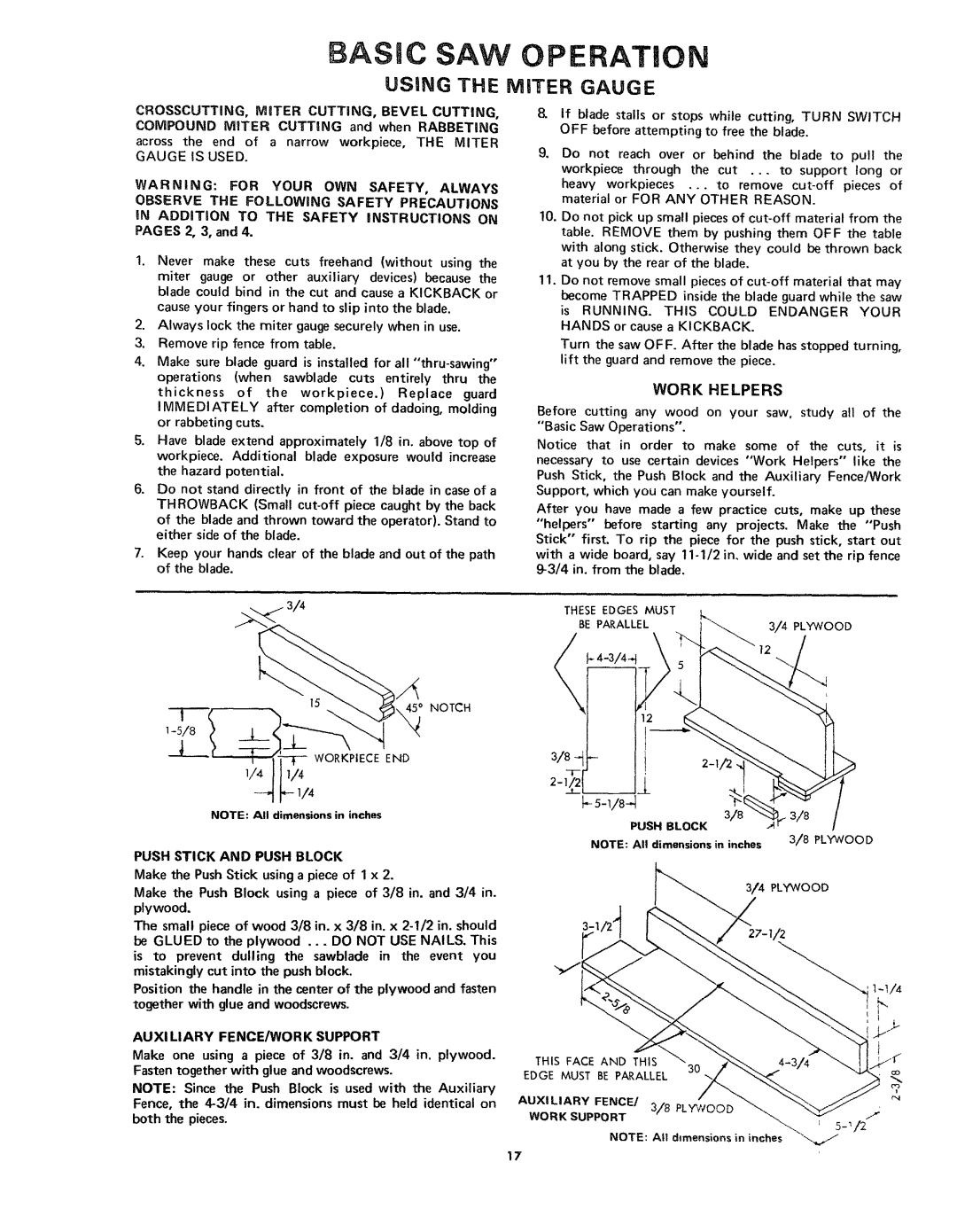
BASIC SAW
USING THE
CROSSCUTTING, MITER CUTTING, BEVEL CUTTING,
COMPOUND MITER CUTTING and when RABBETING across the end of a narrow workpiece, THE MITER GAUGE IS USED.
WARNING: FOR YOUR OWN SAFETY, ALWAYS OBSERVE THE FOLLOWING SAFETY PRECAUTIONS
iN ADDITION TO THE SAFETY iNSTRUCTIONS ON
PAGES 2, 3, and 4.
1.Never make these cuts freehand (without using the
miter gauge or other auxiliary devices) because the
blade could bind in the cut and cause a KICKBACK or cause your fingers or hand to slip into the blade.
2.Always lock the miter gauge securely when in use.
3.Remove rip fence from table.
4.Make sure blade guard is installed for all
operations (when sawblade cuts entirely thru the
thickness of the workpiece.) Replace guard
IMMEDIATELY after completion of dadoing, molding or rabbeting cuts.
5.Have blade extend approximately 1/8 in. above top of
workpiece. Additional blade exposure would increase the hazard potential.
6.Do not stand directly in front of the blade in case of a
THROWBACK (Small
7.Keep your hands clear of the blade and out of the path of the blade.
15450 NOTCH
WORKPIECE END
1/4 I14 1/4
NOTE: All dimensions in inches
OPERATION
MITER GAUGE
8, If blade stalls or stops while cutting, TURN SWITCH
OFF before attempting to free the blade.
9.Do not reach over or behind the blade to pull the
workpiece through the cut ... to support long or
heavy workpieces ... to remove
10.Do not pick up small pieces of
11.Do not remove small pieces of
is RUNNING. THIS COULD ENDANGER YOUR HANDS or cause a KICKBACK.
Turn the saw OFF. After the blade has stopped turning, lift the guard and remove the piece.
WORK HELPERS
Before cutting any wood on your saw, study all of the "Basic Saw Operations".
Notice that in order to make some of the cuts, it is
necessary to use certain devices "Work Helpers" like the
Push Stick, the Push Block and the Auxiliary Fence/Work Support, which you can make yourself.
After you have made a few practice cuts, make up these
"helpers" before starting any projects. Make the "Push Stick" first. To rip the piece for the push stick, start out
with a wide board, say
THESE EDGES MUST
BE PARALLEL | 3/4 PLYWOOD |
| |
| 12 |
_ |
|
3/8 3/8
PUSH BLOCK
NOTE: All dimensions in inches 3/8 PLYWOOD
PUSH STICK AND PUSH BLOCK
Make the PushStick usinga piece of 1 x 2.
Make the Push Block using a piece of 3/8 in. and 3/4 in. plywood.
The small piece of wood 3/8 in. x 3/8 in. x
Position the handle in the center of the plywood and fasten together with glue and woodscrews.
AUXI LIARY FENCE/WORK SUPPORT
Make one using a piece of 3/8 in. and 3/4 in. plywood.
Fasten together with glue and woodscrews.
NOTE: Since the Push Block is used with the Auxiliary Fence, the
THIS FACE AND THIS
EDGE MUST BE PARALLEL 30
AUXILIARY FENCE/ 3/8 PLYWOOD
WORK SUPPORT
NOTE: All dimensions in inches
17
